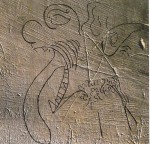 The Norfolk Medieval Graffiti Survey (NMGS) is a community archaeology project which enlisted volunteers to document pre-Reformation graffiti in Norfolk churches. From January 2010 until June 2012, project workers did completely surveys of 65 of Norfolk’s medieval churches (10% of the total) and preliminary surveys of another 40. Medieval graffiti were discovered in 80% of the surveyed churches.
The Norfolk Medieval Graffiti Survey (NMGS) is a community archaeology project which enlisted volunteers to document pre-Reformation graffiti in Norfolk churches. From January 2010 until June 2012, project workers did completely surveys of 65 of Norfolk’s medieval churches (10% of the total) and preliminary surveys of another 40. Medieval graffiti were discovered in 80% of the surveyed churches.
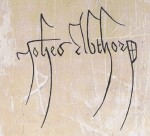 These are some remarkably beautiful and illuminating works. It’s not your standard “Kilroy wuz here” stuff, although names found have found, and it’s definitely not the bawdy libels of Roman Pompeii. They are line drawings, some abstract, some of people, demons, ships and crosses. Circles are also a popular theme. It’s social history, contributions of the regular parishioners who attended church but couldn’t afford to leave their mark by sponsoring rich vestments, dazzling stained glass or soaring bell towers.
These are some remarkably beautiful and illuminating works. It’s not your standard “Kilroy wuz here” stuff, although names found have found, and it’s definitely not the bawdy libels of Roman Pompeii. They are line drawings, some abstract, some of people, demons, ships and crosses. Circles are also a popular theme. It’s social history, contributions of the regular parishioners who attended church but couldn’t afford to leave their mark by sponsoring rich vestments, dazzling stained glass or soaring bell towers.
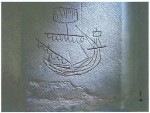 Most of them are inscriptions scratched into the lower walls. They’re hard to see today without making a point of looking for them with the aid of angled lighting, but when they were first made, the lower walls were painted with bold colors so the scratched out images would look white against a bright red, black or ochre background. In some of the churches, the lower walls were crowded with graffiti but they did not overlap, suggesting that people made a point of not messing up earlier works, perhaps because they had a devotional purpose. A ship could have been inscribed as a prayer for a safe voyage, for example. It also suggests the authorities didn’t cover them up or scrape them off but rather tolerated them for very long periods, sometimes centuries even, until the walls were repainted, whitewashed or stripped.
Most of them are inscriptions scratched into the lower walls. They’re hard to see today without making a point of looking for them with the aid of angled lighting, but when they were first made, the lower walls were painted with bold colors so the scratched out images would look white against a bright red, black or ochre background. In some of the churches, the lower walls were crowded with graffiti but they did not overlap, suggesting that people made a point of not messing up earlier works, perhaps because they had a devotional purpose. A ship could have been inscribed as a prayer for a safe voyage, for example. It also suggests the authorities didn’t cover them up or scrape them off but rather tolerated them for very long periods, sometimes centuries even, until the walls were repainted, whitewashed or stripped.
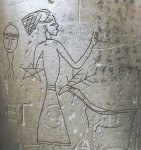 It’s really an extraordinary new vision of medieval church aesthetics. Can you imagine what the walls of these churches looked like at peak graffiti? All those clean white drawings on bold backgrounds must have been like a reverse toile.
It’s really an extraordinary new vision of medieval church aesthetics. Can you imagine what the walls of these churches looked like at peak graffiti? All those clean white drawings on bold backgrounds must have been like a reverse toile.
The project has also discovered important information about church construction. At one of the first sites they explored, Binham Priory, they found an eight-foot inscription depicting the great west window. It wasn’t a free hand drawing, but rather was made using compasses and straightedges, thus NMGS believes it was the work of the master mason who used the wall for architectural drawing.
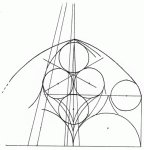 Although much of the drawing was obscured by later painting, it’s a find of major historical significance because the west window’s Gothic bar tracery design was revolutionary when it was built between 1220 and 1245. It was the first of its kind in England, predating its successors by decades. The lower part of the great west window collapsed in the early 19th century and the window was bricked up, so the earliest sketches of the traceried window can provide invaluable information. Already experts who have examined the drawing note that the design is considerably more elaborate than they realized.
Although much of the drawing was obscured by later painting, it’s a find of major historical significance because the west window’s Gothic bar tracery design was revolutionary when it was built between 1220 and 1245. It was the first of its kind in England, predating its successors by decades. The lower part of the great west window collapsed in the early 19th century and the window was bricked up, so the earliest sketches of the traceried window can provide invaluable information. Already experts who have examined the drawing note that the design is considerably more elaborate than they realized.
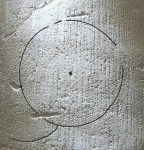 The next step for the project is to expand the massively successful pilot program into a full survey of the remaining 90% of Norfolk’s medieval churches. Volunteers are very much needed, so if you’re in Norfolk and want to have a unique opportunity to scour the walls of churches for centuries-old graffiti, call Project Director Matthew Champion at 07810 677723 or email info at medieval-graffiti.co.uk. You can also contact them via their Facebook page.
The next step for the project is to expand the massively successful pilot program into a full survey of the remaining 90% of Norfolk’s medieval churches. Volunteers are very much needed, so if you’re in Norfolk and want to have a unique opportunity to scour the walls of churches for centuries-old graffiti, call Project Director Matthew Champion at 07810 677723 or email info at medieval-graffiti.co.uk. You can also contact them via their Facebook page.
The program’s success has inspired six other counties to launch similar projects, so check your local listings.